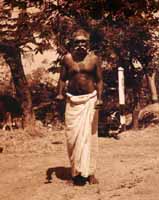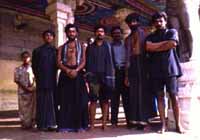|
 There is a sensual languor to the rhythms of life in the South of India. In the South, men wear the longi, a loincloth that is simple piece of homespun cloth tied
around their waist. This cloth is of varying lengths, from upper thigh to ankle length. I often saw men walking down the road tying and untying, wrapping
and unwrapping their longis. A cloth of floor length was often gathered up and wrapped around the waist so it would balloon out and cover the lower torso and
upper thighs. The continual fiddling with the longi seemed to me a sort of a meditation, an autoerotic male display. There is a sensual languor to the rhythms of life in the South of India. In the South, men wear the longi, a loincloth that is simple piece of homespun cloth tied
around their waist. This cloth is of varying lengths, from upper thigh to ankle length. I often saw men walking down the road tying and untying, wrapping
and unwrapping their longis. A cloth of floor length was often gathered up and wrapped around the waist so it would balloon out and cover the lower torso and
upper thighs. The continual fiddling with the longi seemed to me a sort of a meditation, an autoerotic male display.
The women of the South are wrapped in sinuous layers of cloth, most time exposing their beautiful midriff. Softly rounded bellies, bejeweled toes,
bangles on the arms, pierced ears and noses, entranced me with their sensuality.
As a visitor, I try to be very respectful of my host country’s customs. Indian
dress is very modest by Western standards. Women do not show their legs. At a minimum, shirts should have sleeves and not be low-cut. In the areas
that are Muslim it is preferred that women completely cover their legs and arms. The men's stores were my favorite place to shop for appropriate shirts
. They have very fine cottons and I learned to keep one of these large and comfortable shirts with me to wear as an additional cover-up.
As a western woman, I am used to traveling alone. This is certainly not the
norm in India. Most of the time I felt I was viewed as a curiosity, like a monkey let loose in the zoo. Only once, in a Muslim enclave outside of
Kumarakom, did I feel unwelcome. It was my sense, from the angry glances I received from men in the market place, that I should not be there alone.
If it's Tuesday it must be Trivandrum. The road to Trivandrum from Kochi
winds along the Malabar Coast that is known around the world for its pepper and other spices. The hills seem to be carpeted in an impressionist's green
with the tea and spices that are cultivated in this region. Many shops sell the fragrant spices that are treasured around the world. Steps cut into the red
earth of the hillsides have been worn down by generations of farmers.
As I headed to Trivandrum, I was on my way to visit the last-ever Elephant Festival, which I thought was going to be a parade of elephants. Seeing
elephants had become fairly commonplace by now. They seemed to be everywhere. Often they had chains around their necks and were led around
like big dogs. I saw people bathing their elephants in ditches along the side of the road, elephants eating bananas in front of teashops.
 I am still not over the "elephant parade." I was instantly pulled into the drama of the brightly decorated caparisoned elephants. For hours the
elephants stand in place while musicians blow horns and beat on drums. There is a sameness that makes you begin to wonder what you are missing in this
groove that seems to skip back to its beginning after just a few phrases. The sultry heat along with the auditory repetition was a classic example of aversion
therapy. It still gives me chills to remember it. And I am still grateful to the elephant handler who smacked me with his stick. While photographing the
elephants, I did not realize I was so close that one of them was ready to step on me. Even if he had spoken English, I probably wouldn't have heard his warning. I am still not over the "elephant parade." I was instantly pulled into the drama of the brightly decorated caparisoned elephants. For hours the
elephants stand in place while musicians blow horns and beat on drums. There is a sameness that makes you begin to wonder what you are missing in this
groove that seems to skip back to its beginning after just a few phrases. The sultry heat along with the auditory repetition was a classic example of aversion
therapy. It still gives me chills to remember it. And I am still grateful to the elephant handler who smacked me with his stick. While photographing the
elephants, I did not realize I was so close that one of them was ready to step on me. Even if he had spoken English, I probably wouldn't have heard his warning.
Elephants have very intelligent eyes and seem to take in all that goes on
around them. I am certain that one particular elephant had a strong dislike for me. I could tell by the way that he squinted his eyes when he looked at me.
I made sure to keep my distance from him. At the end of the event, as the elephants paraded out, two of the handlers riding on top fell off their elephants
and had to be carried away. It is still puzzling to me: who were these men who seemed to fall so easily off these great lumbering beasts? Why would
they be astride such an animal if their position was so precarious?
Sometimes I had the feeling of never quite knowing where I was. Could I
ever have envisioned a place where people chip away at boulders all day to make gravel for roads? How could I classify this place where I was on a
temporary visa, this place called India? In conversations with my driver Ramesh and other local people I kept hearing about "the black people." They
would be mentioned in conversations about temples and towns, eg.: "there are many black people here." References to them just kept popping up. From the tone used to  describe them it was apparent that they were respected. I would look around and I could see no "black people."
With minor variations, everyone seemed to have a similar complexion. I kept asking who these black people were, but we didn't have an adequate shared vocabulary to reach an understanding. One day we were stopped in a insane throng of people and government officials at a border crossing. There were snaking lines of men, lines held in place by
flimsy wooden barriers. They were standing patiently as if they were waiting in a line for a ride at an amusement park. All of these men were dressed in
black pants and long sleeved black shirts. These were "the black people." Ramesh began pointing at them and telling me that these were the black
people. They are pilgrims on a spiritual quest who visit the many temples in India. describe them it was apparent that they were respected. I would look around and I could see no "black people."
With minor variations, everyone seemed to have a similar complexion. I kept asking who these black people were, but we didn't have an adequate shared vocabulary to reach an understanding. One day we were stopped in a insane throng of people and government officials at a border crossing. There were snaking lines of men, lines held in place by
flimsy wooden barriers. They were standing patiently as if they were waiting in a line for a ride at an amusement park. All of these men were dressed in
black pants and long sleeved black shirts. These were "the black people." Ramesh began pointing at them and telling me that these were the black
people. They are pilgrims on a spiritual quest who visit the many temples in India.
Ramesh was one of my windows to India. As he drove me around the
country, he and his wife were expecting their first child. I had been enticed to India by a friend who was born and raised in Bombay. She has spent the
second part of her life in Houston. Who better to show me the India that would be unavailable to an outsider? Very quickly, though, I found that my
view of India while traveling with her would be limited to her own experience within the culture. She came from a wealthy Sikh family could not
understand my desire to wander to streets and the markets, to meet people, to explore. Somewhat reluctantly, she assisted me in engaging a driver from a
reputable company. She warned him that I wander off and away we went.
I always sat in the front seat with him so I could see everything that was going
on. He quickly became attuned to my eye. We were constantly pulling off the road so I could photograph. Often, he would anticipate my desires. We
went on detours I couldn't find on the maps. It sometimes felt as though he had managed to become my eyes. He took me to places that brought me to tears of joy with their sublime beauty.
|